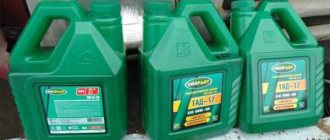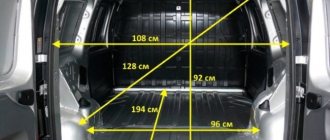VAZ 21214 engine modifications and their differences
| Motor modification | Availability of power steering | An exhaust manifold | EURO environmental class |
| 21214-41 | welded from stainless steel become | 3 | |
| 21214-34 | _ | cast iron | |
| 21214-33 | |||
| 21214-32* | |||
| 21214-31 | welded from stainless steel become | 4 | |
| 21214-30 | — |
*21214-32 – has fuel pipes with quick connectors, a flywheel for the clutch of 215 mm (200 mm on other models).
The geometry of the cylinder block 21214 and 21213 is the same. There are no liners in the cylinders. Due to the use of an ejector, the configuration of the front engine cover has been changed to accommodate the installation of a crankshaft position sensor. To mount the power steering, a hole is made on the block for installing a bracket; in addition, there is a threaded hole for installing a knock sensor, as well as threaded holes with studs for mounting the ignition module bracket.
The ShPG came from 21213. Crankshaft 21213-1005015 sets the piston stroke to 80mm. The crankshaft pulley is distinguished by the presence of teeth along the outer diameter for the operation of the crankshaft position sensor. The latest internal combustion engine models are equipped with a damping pulley (21214-1005058-10). The presence of a damper made it possible to reduce the load on the crankshaft to prevent cutting of the key, and also make the operation less noisy.
Cylinder head 21214-1003011-30 (36) was modified from the head from 21213. For modification, it was necessary to introduce holes for installing a phase sensor and studs for mounting the intake receiver. To install hydraulic compensators, bosses are cast in the head and have threaded holes in them. With the introduction of hydraulic thermal gap compensators, adjusting bolts were eliminated from the head design.
Oil under pressure is supplied to the hydraulic compensators through separate pipes. There are two types of heads: Russian 21214-1003015 and Canadian 21214-1003015-30. The differences between the heads are as follows: in the first, the diameter of the threads in the holes for hydraulic compensators is M18/1.5, the wells for hydraulic compensators do not have drainage holes;
the second ones have M24x1.5 holes, and the wells have drainage holes (the markings are made in the casting). Interchangeability of heads, as well as hydraulic supports of old and new designs, is not possible. A new oil rail 21214-1007180-30 made of stainless steel is used, supplying oil to the hydraulic compensators. Interchangeability with ramp 21214-1007180 is maintained.
Valve levers 21214-1007116-30, in contrast to the previous 2101-1007116, have a smaller radius (11 mm) of the platform support interacting with the camshaft cam, as well as an additional groove on the side of the hydraulic compensator. Both lever options are interchangeable.
In the timing camshaft drive, instead of a double-row chain, a single-row chain 21214-1006040-03 is used on rollers and bushings. Single-row sprockets for the chain are taken from the 2123 engine. The oil pump sprocket has the number of teeth reduced to 30 to increase the performance of the oil pump and improve the operation of the hydraulic chain tensioner and hydraulic compensators.
The camshaft 21214-1006010 is original with a modified cam profile and can be interchanged with the shaft from 21213.
The 80 amp generator is the same as the 2112, with a slight difference in the diameter of the pulley 80 mm for the drive belt 2107-1308020 (944 mm).
The exhaust manifold can be made of cast iron or stainless steel. The cast iron manifold is made by casting. The stainless steel manifold version has a welded design. A welded manifold is lighter and heats up quickly, which is good for the operation of the catalyst located in the manifold. In addition, an oxygen sensor is installed in the exhaust manifold.
The intake manifold and fuel rail (2123-1144010-11) were borrowed from the 2123 engine. The injectors of the fuel injection system are SIEMENS VAZ 20734 (yellow), injectors (0280 158 110) were installed on early engines.
Ignition module from engine 2112.
Electronic control is carried out by the BOSCH MP 7.9.7 ECU. or JANUARY 7.2 depending on the year of manufacture and modification of the internal combustion engine.
The cooling system began to be assembled using gaskets with an elastic polymer bead, which improved the tightness of the system. The water pump (pump) includes an oil seal (cuff) that is more resistant to wear and loss of properties.
Niva with injection engine
There are quite a few varieties of them, and besides, the car has been produced and will continue to be produced for a long time, while it is constantly being updated and improved. It makes sense to distinguish two varieties.
Although you should probably forget about the first one. These are the first releases of the VAZ-21214 with a single-injection GM . They were manufactured according to the requirements of the export program, when it became almost impossible to sell cars with carburetor engines in the markets of developed countries. And at the same time they were sold on the domestic market. Nowadays it is a rarity; it is much easier to find a carburetor car.
But the second one, constantly changing, continues to come off the assembly line. This is the same VAZ-21214 car (we summarize the entire Niva range in this index, although in fact it is not limited to it), but with a distributed fuel injection system into the intake manifold. Roughly, we can say that it has roots from the Bosch company.
The control of the injection and ignition system is electronic; the controller, in common parlance the brains, collects signals from sensors and controls the injection nozzles, there are four of them, and the supply of sparks to the cylinders. Currently, injection is phased, but it’s probably not worth delving into the technical details. It is worth mentioning only the most important fundamental difference between an injector and a carburetor - in the first case, fuel is injected under pressure into the incoming air , and its quantity is regulated by the opening time of the nozzle, while in the second it is picked up by the vacuum in the air flow from a specially designed atomizer. Like in a spray bottle.
The modern injection system meets the most stringent environmental requirements, therefore the exhaust uses a catalytic converter, a double oxygen sensor to ensure its normal operation, a closed power system without ventilation into the atmosphere, electronic throttle control (the damper is not mechanically connected to the accelerator pedal)
Do-it-yourself engine tuning 2106
Engine NIVA 2121 1.6 l. this is a continuation of the 2103 engine and, in turn, the engine from 2101. The main differences between the VAZ 2106 engine and 2103 are pistons with an increased diameter to 79 mm; the 2106 engine block remains the same. The NIVA 1600 engine also has its own crankcase and oil pump. On the left side, to the left of the fuel pump, there is a place where the engine number 2106 is stamped.
The 2106 engine itself is a carburetor inline 4-cylinder with an overhead camshaft, the timing belt 2106 has a chain drive, a double-row chain, 116 links. The motor belongs to the so-called “classic” series with a high block. The service life of the motor, with careful operation and timely maintenance, exceeds the factory-set 125 thousand.
km and reaches 180-200 thousand km. Despite this, this engine is popularly considered less reliable than the engine from 2103. To extend the life of the engine, timely oil changes and pre-warming before driving are important. In winter, warming up the VAZ 2106 engine lasts about 5 minutes at 1500-2000 rpm, as soon as it starts to idle, you can drive.
Let's start with the oil, untimely oil change in the 2106 engine or saving and using low-quality oil leads to the fact that after a run of 60,000 km, the cylinder diameters will increase by 0.15 mm, forget about cheap oils. In addition, it often happens that the VAZ 2106 engine consumes more than a liter of oil per 1000 km.
In this case, we measure the compression and, based on this, determine the malfunction. On NIVA 1600 engines there is a problem of increased wear of the camshaft. Like all previous Zhiguli engines, this VAZ 2106 engine needs valve adjustment, each maintenance is 10 thousand km, a loud knocking sound when the engine is idling, heard from the driver’s seat with the hood closed, indicates exactly this.
Also interesting: Niva engines
We can talk about sounds and knocking in six engines forever, in addition to the above-mentioned valves, the main causes of noise in the VAZ 2106 engine include detonation, why the engine detonates - low-quality fuel, carbon deposits in the combustion chamber and incorrect ignition setting, adjust the ignition, pour normal gasoline and the problem disappears.
Does the engine knock making a metallic sound? These are piston pins or connecting rod bearings; you need to urgently go to a service center.
Does the sound appear while the engine is warming up and is it similar to the knocking of clay dishes? The problem is in the pistons, you can slowly get to the service station. A knock in the VAZ 2106 engine coming from the bottom of the engine simultaneously with a drop in oil pressure indicates a problem with the main bearings, we turn off the car and go to the service in tow.
If the noise is more like a creaking sound in the VAZ 2106 engine, check the tensioner and timing chain tensioner; if there is a grinding noise, check the pump bearing. Unstable operation of the VAZ 2106 engine is common on carburetor cars; clean the carburetor jets.
If the VAZ 2106 engine stalls at idle, while the idle speed is adjusted normally, adjust the air damper.
If it stalls while driving, the reason is in the power supply or ignition system. Is the 2106 engine heating up or boiling? We check the thermostat, radiator, possibly the air in the cooling system, these are the main points causing overheating.
Trouble with VAZ 2106 engine? The main reasons: the valves were adjusted incorrectly, the valve burned out, the cylinder head gasket failed, this will be indicated by the jumping temperature of the coolant, increased smoke from the exhaust system (white smoke). The reasons for engine tripping also include low-octane gasoline, an incorrectly adjusted carburetor, the same carburetor can be the reason why the VAZ 2106 engine jerks, but if it holds idle, look at the ignition system.
Does the VAZ 2106 engine smoke a lot? These are oil scraper rings or valve seals, take the car to a service center and get ready for a major overhaul. Pay attention to the engine mounts, they can cause engine vibration; if the mounts are worn out, go to a service station to replace them. In addition, engine vibration can be caused by an imbalance of the crankshaft and driveshaft, different pistons and other reasons. All this is diagnosed and eliminated in the service conditions.
and 1.8l.
Signs of jamming
Let's start with the fact that if the engine jams, then the engine actually does not turn.
When such a malfunction occurs while driving, the power unit either suddenly stalls or the power drops noticeably and then the operation of the internal combustion engine stops. It is impossible to start the car again, at least not right away. In this case, the starter will not turn, or when you try to start, you can hear a grinding and squealing noise, or you can hear metal hitting metal.
Also interesting: Niva Chevrolet installation of air conditioning - Auto magazine MyDucato
Sometimes, after being idle, the engine still manages to start, but it will not work for long. In some cases, engine seizure is also preceded by a distinct metallic knocking or rattling noise under the hood.
Technical characteristics of the internal combustion engine VAZ 21214
| Volume, cm3 | 1690 |
| Main fuel: | gasoline AI-92 |
| Max. power, l. With. | 83 (at 5200 rpm) |
| Max. torque, Nm | 127 (at 3000 rpm) |
| Cylinder block configuration: | in one row |
| Number of cylinders | 4 |
| Number of valves | 8 |
| Max. speed, km/h | 153 |
| Acceleration time to 100 km/h, sec. | 17 |
| Combined fuel consumption | 11,5 |
| Econorm | Russia-83 |
| Cylinder diameter, mm | 82 with deviation up to 0.05 |
| Piston stroke, mm | 80 |
| Repair dimensions of pistons and cylinders, mm: | |
| first repair (marking on the piston - triangle, on the rings - 40) | 82.4 |
| second repair (marking on the piston - square, on the rings - 80) | 82.8 |
| Repair measurement of the diameter (for boring) of the crankshaft supports | 54.52 with deviation up to 0.013 |
| Compression ratio | 9,4 |
| Supply system | two-barrel carburetor |
| Cooling | liquid |
| Valve mechanism | SOHC |
| Cylinder block material | cast iron |
| Presence of liners in cylinders | not provided for by design |
| Head material | aluminum alloy |
| Resource before major overhaul, km | 80,000 (actual ≈ 120,000 km) |
| Number of bars | four |
| Cylinder operating order | 1-3-4-2 |
| Max. speed, rpm | 8000 |
| Weight, kg: | 117 |
| Volume, cm3 | 1690 |
| Poppy. power, l. With., | 83 |
| Max. torque, Nm | 129 |
| Arrangement of cylinders in the block | in-line |
| Cylinders, pcs. | 4 |
| Valves, pcs. | 8 |
| Max. speed, km/h | 142 |
| Acceleration to 100 km/h | 17 |
| Combined fuel consumption | 10 |
| Environmental standards | EURO-4 |
| Cylinder diameter, mm | 82 |
| Piston stroke, mm | 80 |
| Compression ratio | 9,4 |
| Supply system | distributed injection |
| Cooling | liquid |
| Valve mechanism | SOHC |
| Cylinder block material | cast iron |
| Cylinder head material | aluminum |
| Resource, km | 80,000, in fact up to 150,000 |
| Clock (number of clock cycles) | 4 |
| Cylinder operating order | 1-3-4-2 |
| Max. c/v speed, rpm | 8000 |
| Recommended fuel | unleaded gasoline AI-95 |
And also interesting: Chevy Niva roof racks in Balashikha, buy inexpensively in the online store with delivery | 40NOG
Specifications
The Niva engine has high technical characteristics, and the car itself has increased cross-country ability, since there is a 4x4 option. Over the history of production, the VAZ 2121 has had different engine versions installed, from a carburetor version to an injector and even a diesel version.
So, let's look at the main characteristics of modifications to the Niva power unit:
VAZ 2121
| Name | Index |
| Engine capacity | 1.6 liter (1580 cc) |
| Number of cylinders | 4 |
| Number of valves | 8 |
| Fuel | Petrol |
| Injection system | Carburetor |
| Power | 80 horsepower |
| Fuel consumption | 12.2 l/100 km |
| Cylinder diameter | 79 mm |
| Valve mechanism | SOHC |
VAZ 21213
| Name | Index |
| Engine capacity | 1.7 liter (1690 cc) |
| Number of cylinders | 4 |
| Number of valves | 8 |
| Fuel | Petrol |
| Injection system | Carburetor |
| Power | 82 horsepower |
| Fuel consumption | 11.0 l/100 km |
| Cylinder diameter | 82 mm |
| Valve mechanism | SOHC |
VAZ 21214
| Name | Index |
| Engine capacity | 1.6 liter (1580 cc) |
| Number of cylinders | 4 |
| Number of valves | 8 |
| Fuel | Petrol |
| Injection system | Injector |
| Power | 83 horsepower |
| Fuel consumption | 8.4 l/100 km |
| Cylinder diameter | 82 mm |
| Econorm | EURO-4 |
| Valve mechanism | SOHC |
VAZ 2131
| Name | Index |
| Engine capacity | 1.8 liter (1779 cc) |
| Number of cylinders | 4 |
| Number of valves | 16 |
| Fuel | Petrol |
| Injection system | Injector |
| Power | 94 horsepower |
| Fuel consumption | 9.2 l/100 km |
| Cylinder diameter | 82 mm |
| Econorm | EURO-4 |
| Valve mechanism | SOHC |
Engine XUD9SD manufactured by Peugeot
| Name | Index |
| Motor type | Diesel |
| Engine capacity | 1.9 liter (1905 cc) |
| Number of cylinders | 4 |
| Number of valves | 8 |
| Fuel | Diesel fuel |
| Power | 75 horsepower |
| Fuel consumption | 7.1 l/100 km |
The power units of the VAZ 2121 were equipped with 4-speed manual and 5-speed manual transmissions.
Description of the injection engine
Repair of an injection engine, procedure for assembling and disassembling the Niva 2121 engine head, stages of removing and installing Niva 2131 valves, instructions for replacing the camshaft of Niva 2131, VAZ 2121.
Operation and maintenance of the fuel injection, ignition, exhaust system Niva 2121. Injection engine, carburetor engine. Design of the carburetor and injection power system of Niva 2131.
1 – oil pan; 2 – generator mounting bracket; 3 – cylinder block; 4 – power unit support cushion; 5 – power unit support bracket; 6 – clutch housing cover; 7 – flywheel; 8 – knock sensor; 9 – exhaust manifold; 10 – heat shield of the inlet pipe; 11 – inlet pipe; 12 – receiver; 13 – throttle assembly; 14 – fuel rail; 15 – cylinder head cover; 16 – outlet pipe of the cooling jacket; 17 – cylinder head; 18 – hydraulic chain tensioner; 19 – coolant pump pulley; 20 – camshaft drive cover; 21 – crankshaft position sensor; 22 – oil filter; 23 – crankshaft pulley mounting nut; 24 – crankshaft pulley; 25 – coolant pump cover; 26 – coolant pump housing.
Gasoline, four-stroke, four-cylinder, eight-valve, in-line, overhead camshaft.
The operating order of the cylinders is: 1–3–4–2, counting from the crankshaft pulley. Power supply system – distributed injection, Niva 2131 engine control – “BOSCH MP7.0” controller (Euro-2 toxicity standards). A catalytic converter is installed in the exhaust system.
On the right side of the engine (along the direction of the car) are located: a receiver with a throttle assembly, a throttle position sensor and an idle speed regulator, an intake pipe and an exhaust manifold, a fuel rail with injectors and a fuel pressure regulator, knock sensors and coolant temperature sensors (for the injection system) , generator, thermostat, starter (on the clutch housing). The air filter housing with mass air flow sensor is mounted on a separate bracket to the right of the engine.
On the left side of the engine are located: spark plugs and high voltage wires, an ignition module, an oil level indicator, an oil filter, coolant temperature and oil pressure sensors (control devices). Front: coolant pump and generator drive (V-belt), crankshaft position sensor.
The cylinder-piston group is the same as for the mod. 21213 (see VAZ-21213 engine). At the toe of the crankshaft there is a drive pulley for the generator and coolant pump with a toothed disk - for reading information by the Niva 2121 crankshaft position sensor. The disk has 58 teeth (the circle is divided into 60 teeth, but two are missing, forming a cavity - this is necessary to obtain a synchronization impulse each revolution of the crankshaft). Camshaft drive cover mod. 21214 is different from the cover mod. 21213 with a boss with a hole for the crankshaft position sensor.
The timing mechanism is driven by a single-row chain. Accordingly, the sprockets of the crankshaft and camshaft, as well as the oil pump drive shaft, are also single-row; they are not interchangeable with engine parts mod. 21213. At the same time, the number of teeth of the oil pump drive shaft sprocket was reduced from 38 to 30 (speed synchronization for the operation of the ignition sensor-distributor is not needed here), thereby increasing the performance of the oil pump (this is necessary in connection with the advent of a hydraulic chain tensioner and hydraulic mounts for valve levers) .
Tensioner shoe mod. 21214 is significantly longer than the shoe mod. 21213. It, like the chain guide, is made of wear-resistant plastic. Their attachment points have also been moved. The rotation axis of the tensioner shoe is located in the lower part of the cylinder block, to the right of the crankshaft sprocket (in its place in the engine model 21213 there was a limit pin).
The tensioner is spring-hydraulic: the preliminary tension of the chain (with the engine off) is provided by a spring, the working tension (after starting the engine) is by the pressure of oil under pressure, which is supplied through a steel tube from the adapter under the emergency oil pressure sensor.
Instead of adjusting bolts, the valve mechanism is equipped with hydraulic supports for the valve levers (hydraulic clearance compensators). They are powered by oil under pressure, supplied through a separate tube from the hole in the camshaft bearing housing near the middle stud of its mounting. Due to the fact that there are practically no gaps in the valve mechanism, the springs that press the valve levers on the mod engine are not installed. 21213. The shape of the camshaft cams is also different.
Conclusion
VAZ 2121 engines are reliable, but have a short mileage before major repairs. Although, on the other hand, it is quite simple and quick to overhaul Niva power units, they are not picky about spare parts, and their cost is quite low.
Hello everyone! Today we’ll talk, strange as it may seem, about fields. More precisely, about two specific cars. 1- This is a VAZ 21219 (modification of a VAZ 2121) and 2- a VAZ 2130 Nadezhda! So let's start with the history of these cars. in order to introduce people who are not very close to VAZ SUVs!
And so for starters, VAZ 2121 NIVA!
VAZ 2121 Niva is a super popular SUV from AvtoVAZ, created on the basis of the VAZ 2106. The engine remains the 1.6L six, but with cosmetic modifications. Subsequently, on its basis, a 213 1.7-liter engine and a 2130 1.8-liter engine were created. The 214 injection engine was also used. In parallel with the Niva 2121, a Chevrolet Niva with a slightly modified 213 engine was also produced; technically and structurally, this car is very close to the regular VAZ 21213.
Also, at one time, on the basis of the VAZ 21214, at the OPP, a minivan with all-wheel drive was produced - Lada Nadezhda. The engine was from 2106. VAZ 2106 1.6 liter engine. continuation of the triple engine and, in turn, the penny motor. The main differences between the VAZ 2106 engine and the 2103 are the piston has an increased diameter to 79 mm; the engine block of the 2106 remains the same.
By the way, on the left side of it, to the left of the fuel pump, there is a place where the engine number 2106 is stamped, many cannot find it, this information will solve your problem once and for all. There is also an injector engine 21067, it is a regular six-wheel engine covered with a cylinder head from the injector Niva engine 21214, in fact, all the differences.
As time and practice have shown, a six-cylinder carburetor engine is more stable than an injection engine. The 2106 engine itself is an injection or carburetor inline 4-cylinder with an overhead camshaft, the 2106 timing belt has a chain drive. The motor belongs to the so-called “classic” series with a high block.
And also interesting: Do-it-yourself headlight range control repair; video about hydraulic correctors «
The service life of the engine, with careful operation and timely maintenance, exceeds the 125 thousand km established by the factory and reaches 180-200 thousand km. Despite this, this engine is popularly considered less reliable than the engine from 2103. In order for the engine to live happily ever after, it must be warmed up before driving.
VAZ-21219 is a transitional combined modification with a body and suspension from the VAZ-2121 and a 1.7-liter engine and transmission from the VAZ-21213. The interior and rear window washer reservoir were also retained from the VAZ-2121. It was produced in 1993-1994. The engine was installed: VAZ 21213 1.7 liter engine. carburetor/injection(21214)
in-line 4-cylinder with overhead camshaft, Niva timing belt has a chain drive. Based on the 214 engine, the VAZ 2123 engine is produced for the Chevy Niva; the differences in adapting the block for installing a pulley in the engine compartment and mounting attachments are technically almost identical.
The main differences between the VAZ 21213 engine and the 2106 are the cylinder diameter is 82 mm, the cylinder head, the Niva 21213 engine block from the 2106 is smaller in height. Among the advantages of the 213 engine, it is worth noting the presence of a chain tensioner (no need to tighten it) and hydraulic compensators (no need to adjust the valves).
And finally, VAZ 2120 Nadezhda
VAZ 2120 Nadezhda is a minivan from AvtoVAZ with all-wheel drive. It was developed on the basis of the Niva 2121 and differed little from it structurally. Serial production of the car was never established, the reason for this was the inflated price, general low quality and, accordingly, lack of consumer interest. The base engine of the VAZ 2120 was the Nivov 2130 1.8 liter engine.
Along with it, a 21214 1.7i injection engine was also installed. The VAZ 2130 1.8 liter engine. carburetor/injection in-line 4-cylinder with overhead camshaft, timing belt 2130 has a chain drive. The engine belongs to the so-called “classic” series with a high block. Compared to the Niva block 21213, the VAZ 2130 engine block is 1.3 mm higher, thanks to this it became possible to install a crankshaft with a piston stroke of 84 mm and obtain a volume of 1.8 liters.
The VAZ 2130 engine knocks, heats up, and troits like a classic one, and all the problems of sixes and sevens are here too. In addition, engines have the problem of increased camshaft wear, as well as the need for regular (every 7-10 thousand km) adjustment of valve clearances, this is indicated by a loud knocking sound when the engine is idling, which can be heard from the driver’s seat with the hood closed.
So why did I start this whole topic! Recently, a man came up to my car and began to inspect the car and asked a bunch of questions about modifications. The questions were banal. What kind of tires, who the manufacturer is, how it performs in the mud, how it does on asphalt, how it makes noise, what kind of lift, what is the consumption with modifications and all that sort of thing... Then he asked about the engine. I answered that the carburetor 1.7 was bored out to 1.8, in total there is a 213 engine from 21219.
Next, a question was asked for the shaft! Of course, it is native, an ordinary Niva-val. Then he asked why he didn’t put it from Nadezhda? And then it changed for me. Initially, I thought that Nadezhda was powered by ordinary engines from the 06 Lada, or from the Niva 21213 and 21214. As it turned out, this is not the case! Hope has its own engine. This can be clearly seen from the ha-kams of the engines!
Engine VAZ 2106 / 2121 / 21074Characteristics of the VAZ 2106 engine
Engine VAZ 1.6 l. Years of production - (1976 - present time) Cylinder block material - cast iron Power system - carburetor/injector Type - in-line Number of cylinders - 4 Valves per cylinder - 2 Piston stroke - 80 mm Cylinder diameter - 79 mm Compression ratio - 8.5 Engine displacement 2106 - 1569 cm3
Engine power 2106 – 75 hp. /5400 rpm Torque - 116 Nm / 3000 rpm Fuel - AI92 Fuel consumption - city 10.3 l. | track 7.4 l. | mixed 10l/100 km Oil consumption - 700 g per 1000 km Overall dimensions of engine 2106 (LxWxH), mm - 565x541x665 Weight of engine 2106 - 121 kg Oil in engine 2106: 5W-305W-4010W-4015W-40 How much oil is in engine 2106: 3.75 l. When replacing, fill about 3.5 l.
Also interesting: Engine jammed: causes, ways to fix the problem
VAZ 2106 engine life: 1. According to the plant – 125 thousand km2. In practice – up to 200 thousand km
TUNING Potential – 200 hp. Without loss of resource – 80 hp.
The engine was installed on: VAZ 2106 VAZ 2121 Niva VAZ 21074
Engine VAZ 21213 / 21214 / 21219 NivaCharacteristics of the Niva engine
Years of production – (1994 – present time) Cylinder block material – cast iron Power system – carburetor (21213) / injector (21214) Type – in-line Number of cylinders – 4 Valves per cylinder – 2 Piston stroke – 80 mm Cylinder diameter – 82 mm Compression ratio – 9.4 Engine displacement Niva 21213 – 1690 cm3
Engine power Niva 21213 – 81 hp. /5200 rpm Torque - 125 Nm / 3000 rpm Fuel - AI93 Fuel consumption - city 11.5 l. | track 8.3 l. | mixed 10.5 l/100 km Oil consumption - 700 g per 1000 km Niva engine weight - 117 kg Overall dimensions of the Niva engine 21213 (LxWxH)
Niva engine life: 1. According to the plant – 80 thousand km2. In practice – up to 150 thousand km
TUNING Potential – 200 hp. Without loss of resource – 90 hp.
The engine was installed on: VAZ 21219 Niva VAZ 21213 Niva VAZ 21214 Niva Chevrolet Niva
Engine VAZ 2130 Niva Nadezhda 1.8 Engine 2130 characteristics
Years of production – (1993 – present time) Cylinder block material – cast iron Power system – carburetor/injector Type – in-line Number of cylinders – 4 Valves per cylinder – 2 Piston stroke – 84 mm Cylinder diameter – 82 mm Compression ratio – 9.4 Engine volume – 1774 cm3 Power 2130 – 82 hp /5200 rev.
minTorque – 139 Nm/3200 rpm Fuel – AI93 Fuel consumption – city 16.5 l. | track 9.7 l. | mixed 12.1 l/100 km Oil consumption - 700 g per 1000 km Weight of the VAZ 2130 engine - 122 kg Geometric dimensions of the VAZ 2130 engine (LxWxH), mm - 560x350x710 Oil in the VAZ 2130 engine: 5W-305W-4010W-4015W-40 How much oil is in the engine 2130: 3.75 l. When replacing, fill in about 3.5 liters. up to risks MAX
Resource 2130:1. According to the plant – 80 thousand km2. In practice – 150-180 thousand km
TUNING Potential – 200 hp. Without loss of resource – 80 hp.
The engine was installed on: VAZ 2120 “Nadezhda” VAZ 2121 “Niva”
Now the question is tormenting me! Is it worth the hassle and installing a Nadezhda shaft on Nivov engines? After all, they put Niva-shafts on penny, triple and six-ruble coins, and there is a result! Or maybe it’s worth replacing the engine altogether with one of the three 2120 engines? I'm interested in whether anyone has installed a shaft from hope in their original engine, or whether they even replaced original motors from 2106 or 21213 with engines from hope?
If changed, what changes in the behavior of the car. (behavior of the car in the city, on the highway, in off-road conditions) The engines of interest are 2120 1.8, 2120 1.7i, 2120m 1.7i. I cannot compare the behavior of Nadezhda and a simple Niva, because the cars have different weights, dimensions, and aerodynamics (which is a specific indicator of the car’s behavior on the track) I’m waiting for your answers and feedback)
Read news about the new Niva
- Clutch adjustment on Niva 21214 - Online reference book to help the car owner - looking for and fixing faults
- How to eliminate vibration of the VAZ-21213 transfer case
- Fuses and relays (location and purpose of fuses and relays) Niva Chevrolet "
- Mud tires for Niva 4x4: radius 15 and 16 - which one is better to install "
- Liquids used and filling volumes Niva VAZ 21213, 21214, 2131 lada 4×4
- Wheel stud M12x1.25x41 2121, 21213, 2131, 21214, 2123 rear
- Niva Chevrolet transfer case: device, connection diagram and how to use?
- How is a CV joint replaced on a Chevrolet Niva?
Weaknesses of the VAZ 21214 engine
Cylinder block. This weak point appears on various models of Nivov engines, including the previously discussed 21213. Due to insufficient quality control, the assembly unit is manufactured with a high percentage of factory defects. In short, the drilling depth of the intake manifold stud holes is not maintained, causing the holes to meet the camshaft stud holes.
In this way, L-shaped through channels are obtained. After installing the studs at the factory, the connections remain sealed for some time and the problem is not identified when the quality control department employees accept engine tests. After the sale of new cars with low mileage, during sharp braking, oil begins to seep through the studs onto the hot intake manifold, so much so that smoke from the oil burning in the manifold pours out from under the hood, and accordingly, there is nothing to breathe in the cabin.
A sketch for the technical specifications for eliminating oil leaks from under the exhaust manifold studs.
- Remove the GC cover;
- Unscrew the two studs securing the bearing housing (see sketch) and remove oil from the threaded holes;
- Thoroughly degrease the holes and stud;
- Apply sealant UG-10 or its analogues to the lower threads of the studs;
- Place the studs in place;
- Tighten the bearing housing nuts;
- Install the cylinder head cover;
- Wait at least 30 minutes for the sealant to set.
- Water pump;
- Engine, manual transmission and transfer case oil seals;
- Generator;
- Starter;
- manual transmission;
- Valve cover gasket;
- Cooling system pipe connections;
- Radiator;
- Thermostat;
- Expansion tank;
- Vacuum brake booster.
Also interesting: What kind of diesel engine can be installed on the Niva?
The water pump (pump) is characterized by frequent failures on new cars after 2,000 km.
Due to poor quality, oil seals require more frequent replacement than required according to the operating manual.
The generator has a high probability of failure. As a rule, it burns out even on new cars that have not reached 4,000-10,000 km.
The starter has a low service life without repair.
On a gearbox, one of the common defects is the fifth gear slipping out. In addition, the gears are not fully engaged.
The valve cover gasket loses its properties over time and allows oil to leak out.
The connections of the cooling system pipes in the places where the clamps are installed are not reliable and lose their tightness very early, which is fraught with loss of antifreeze.
The radiator is leaking. The problem occurs due to the appearance of cracks in the radiator pipe package, accompanied by loss of coolant. This defect has become widespread.
The thermostat does not provide thermal conditions for the coolant in the engine cooling system. The manifestation of this problem is no exception. The cause of the defect is a failure of the valve mechanism inside the thermostat. To check that the thermostat is working properly, after starting the engine, simply place your palm on the lower (outlet) hose, through which hot antifreeze circulates into the radiator for cooling. If the thermostat is working properly, after some time the hose should become hot; if the hose remains cold, the thermostat must be replaced.
The expansion tank cracks and antifreeze leaks out. The appearance of cracks occurs due to the failure of the steam-air valve in the tank plug due to increased pressure.
Vacuum brake booster (VUT). Manifested by a stiff brake pedal. The speed may fluctuate when the brake pedal is pressed, as well as hissing. The problem is solved by replacing failed rubber products and replacing clamps in connections.
Pros and cons of the injector
Which is better - Niva carburetor or injector? This question interests many car enthusiasts. Here are the advantages of the injection Niva:
- Stable operation of the internal combustion engine. Thanks to the presence of IAC, owners have forgotten what floating speed is. For carburetor engines this was a real disease.
- Great performance. The fuel-injected Niva responds more quickly to the gas pedal.
- Less fuel consumption. We have already seen this by looking at the technical specifications. With the arrival of the injector, consumption decreased by 20 percent.
- Excellent starting in any weather. The injection engine does not flood the spark plugs, and in the summer the fuel pump does not overheat. The latter is submersible and is cooled by gasoline, as it is located in the tank.
- Reliability. Since there is no carburetor, there is no need to regularly tune it, change jets and clean it. The maximum that the owner of an injection-powered Niva can do is clean the throttle valve, but this procedure is by no means mandatory. It is recommended to do this only if the car selects high idle speeds.
What are the disadvantages of the fuel-injected Niva? There aren't many of them. Since more electronics have been added to the system, owners may experience faulty control sensors. If the car begins to consume a lot of fuel, it is worth looking at the mass air flow sensor. If the engine does not maintain normal speed at idle, the IAC may be to blame. And if the engine refuses to start, the contact may have come loose from the crankshaft position sensor. But fortunately, these problems don't happen that often. And you can diagnose them with a simple multimeter by measuring the resistance or contact voltage of one of the sensors. Thus, breakdowns mainly concern only electronics. The mechanical part does not raise any questions.
Disadvantages of the VAZ 21214 engine
- Vibration at speed 80-90 km;
- Unreliable timing tensioner design;
- Ignition module;
- The fuel pump is noisy;
- Low torque;
- Long stroke of the gear lever;
- When the timing chain breaks, the valves bend;
- Vibration of the gear lever;
- Poor dynamics on the highway due to insufficient power.
Conclusion.
PS. Dear Nivovody! I look forward to your comments, questions and feedback on the problems that have arisen, weaknesses and shortcomings during the operation, maintenance and repair of the VAZ 21213 engine.
Frequent manufacturing defects (defects) of hydraulic supports of valve levers (hydraulic compensators). Due to the low level of technological discipline and technical control at the enterprises of manufacturers of precision pairs for hydraulic mounts, parts are produced with a high number of defects, and when assembling heads at the parent enterprise (machining tolerances are not maintained, foreign objects are present, the clamping of the plunger in the hydraulic mount housing results in non-compliance with the tightening torque when installing into the head). For this reason, if the hydraulic mounts wear out, you have to install a new head complete with hydraulic mounts.
The latest engine modifications are equipped with time-tested hydraulic valve lever mounts from INA. From them we can say for sure that the risk of deformation of the housing during tightening is reduced to zero. The photo below shows a new type of hydraulic support (with M 24×1.5 thread) in detail (body, plunger) and in assembly.
Low service life before major overhaul. Saving on the quality of the materials used, along with the unreliability of components, parts and assembly units, negatively affects the reliability of the motor and its service life.
PS Dear car owners! What weak points and shortcomings did you encounter with this engine?
Read news about the new Niva
- Clutch adjustment on Niva 21214 - Online reference book to help the car owner - looking for and fixing faults
- How to eliminate vibration of the VAZ-21213 transfer case
- Fuses and relays (location and purpose of fuses and relays) Niva Chevrolet "
- Mud tires for Niva 4x4: radius 15 and 16 - which one is better to install "
- Liquids used and filling volumes Niva VAZ 21213, 21214, 2131 lada 4×4
- Wheel stud M12x1.25x41 2121, 21213, 2131, 21214, 2123 rear
- Niva Chevrolet transfer case: device, connection diagram and how to use?
- How is a CV joint replaced on a Chevrolet Niva?
Useful tips
Unlike mechanical causes, many cases of engine overheating can be avoided if you regularly check the oil level and its condition, as well as monitor the coolant level and monitor the serviceability of individual elements (thermostat, cooling fan, pump and others).
Thus, many of the reasons that lead to the engine jamming can be neutralized in advance. In any case, if you notice signs of a jammed engine while driving (knocking, roaring and other extraneous sounds), it is best to stop moving, and without waiting for the moment until the engine begins to stall on its own.
Also interesting: Engine tuning: Niva 4x4 - increasing power using common methods || Boosting the Niva engine
Read news about the new Niva
- Clutch adjustment on Niva 21214 - Online reference book to help the car owner - looking for and fixing faults
- How to eliminate vibration of the VAZ-21213 transfer case
- Fuses and relays (location and purpose of fuses and relays) Niva Chevrolet "
- Mud tires for Niva 4x4: radius 15 and 16 - which one is better to install "
- Liquids used and filling volumes Niva VAZ 21213, 21214, 2131 lada 4×4
- Wheel stud M12x1.25x41 2121, 21213, 2131, 21214, 2123 rear
- Niva Chevrolet transfer case: device, connection diagram and how to use?
- How is a CV joint replaced on a Chevrolet Niva?
Since what year did the fields become injected?
Good afternoon I’m looking at a Niva, the budget is 100-150 rubles, respectively, for this money 2000-2006, the usual 21214 are injection, but there are also Nivas from the 80s in excellent condition, with natural carburetors. I read that the “Soviet” ones have thicker metal and supposedly have a lot of good things :))) but the new ones have all foil, etc. and so on. I would like to ask anyone who owned old and new to speak out, is there such a big difference, is it true that “they used to do it differently”, or on the contrary, fresher is fresher, after all, improvements were gradually introduced almost every year in different units, probably not in vain? Is a carburetor really that scary in the fields? including consumption?
The third option is to save further and take either a 21214M or a Chevy Niva, where the budget already starts from 300 tr. it turns out. For example, we have a Niva 1980 hanging in our advertisements. ideally for 100 tr. Krasnodar region, so the problem of corrosion is not so relevant here.
Comments 13
In our family we had Nivas from 1987, 2000 and Nivas from recent years (grandfather changes them every 3 years). Niva '87 is a beast of a car. 150 km/h at 4 mortar, V-1600. Of course she periodically demanded attention. Both the body and all the mechanics. I also really liked the Niva 2000 (at that time it was 8-9 years old). It broke very rarely. At that time, my father took it in the north (they don’t pour salt on the roads there). I looked through a lot of them. Everyone was painted. I chose the dirtiest one. It stood in a guy's garage and was used for his summer cottage. Mileage 60 t. km. Well, about injection fields. Good devices. More comfortable, BUT on the vase they strangled Nivov engines with EURO requirements. She just became stupid. I don't know what to do with this. It can flash the brains, or it can stop worrying and take the carburetor. I would try to get a 5-6 year old carburetor.
About 2 years ago, my friends took the Niva. One took a new one from the showroom, and the other took a 1-year-old one, but well stuffed with “craftsmen”. In the “stuffed” one they made noise reduction, covered the interior with leather, installed different seats, installed electric windows and little things. Both comrades are as happy with the Niva as boas. The first one exploited and did not invest, except for consumables and maintenance, and the second did not invest anything at all (only gasoline). Of course, they didn't kill them off-road. Mostly around the city and to the dacha. Without fanaticism. The third acquaintance owned an old Niva (88-89, I think). He was also happy as a boa constrictor, but after going hunting he drove him into the hole and always changed something. He complained that spare parts were expensive and their quality was not so good. I went to tune the carburetor several times. Each time I was not very happy with the result. Either it was running out of fuel, then it was stalling, or some other nonsense. In general, an old car is an old one that requires attention and constant “care”. Therefore, I am for the 3rd option. Save up and take Shniva or at least Niva for no more than 1-2 years. They already come with power steering, it’s becoming more and more pleasant to turn the steering wheel. You can take the old one, in some ways it may be better than the new one, but it will take a lot of time. It may not even be so much a financial investment as a temporary one.
OJSC "Lutsk Automobile Plant" in the third quarter of this year stops assembling carburetor VAZ-21213 cars and switches to producing an injection modification.
| OJSC "Lutsk Automobile Plant" in the third quarter of this year stops assembling carburetor VAZ-21213 cars and switches to producing an injection modification. |











